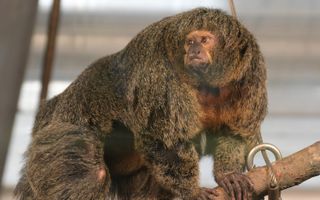Why Does This 'Buff Monkey' Look Ridiculously Ripped?

A monkey in a Finland zoo recently gained a lot of attention on social media for her unusually "buff" body, but she isn't quite as muscular as she appeared.
In the photo, the primate — a female white-faced saki monkey (Pithecia pithecia) named Bea — crouches on a branch in her enclosure at the Helsinki Zoo. Her arms, chest and legs look exceedingly bulky in contrast to her small, glowering face, making her seem as heavily muscled as a steroid-infused bodybuilder.
But in reality, the monkey's muscles aren't all that impressive, and the suggestion of bulk came from Bea fluffing up her abundant fur, zoo representatives told Live Science. [8 Humanlike Behaviors of Primates]
White-faced sakis are native to Brazil and parts of Venezuela and Indonesia, spending most of their time in rainforest canopies at heights up to 82 feet (25 meters) above the ground, according to the University of Michigan's Museum of Zoology.
Bea, the leader of the zoo's white-faced saki monkey troop, was born at the Helsinki Zoo and is 9 years old, zookeeper Merja Wahlroos told Live Science in an email. On average, adult female monkeys weigh about 3 to 4 pounds (1.4 to 1.9 kilograms) with a body length of (32 to 40 centimeters), "and the tail is usually as long as the body," Wahlroos said.
And even though Bea hasn't been measured recently, her size is likely "in the bigger end of the scale," Wahlroos estimated. Nevertheless, Bea's apparent burliness is not the result of rigorous weightlifting and chugging protein shakes; rather, it's an illusion created by her thick, furry coat, zoo representatives explained in a tweet.
Finnish photographer Santeri Oksanen snapped the image in February; he was visiting the zoo to practice taking pictures of wildlife, which he later shared on Flickr, he told Live Science in an email. As Oksanen stood outside the monkey troop's habitat, Bea struck "this epic pose" and surveyed her territory; at that moment, Oksanen captured the photo that later went viral.
Sign up for the Live Science daily newsletter now
Get the world’s most fascinating discoveries delivered straight to your inbox.
"Bea's expression couldn't had been any better," Oksanen said.
Little is known about saki monkey's social habits in the wild, but in captivity the monkeys usually live in small family groups of four individuals, and the most common group is parents and offspring, Wahlroos explained. But saki monkeys can also form groups of multiple males or females that contain up to 12 monkeys. Males generally dominate groups in captive populations, but the group hierarchy is flexible, and sometimes females — like Bea — assume leadership, Wahlroos said.
As for Bea's fabulous floofiness, many types of animals fluff their fur (or feathers) to appear bigger and more intimidating when threatened. However, saki monkeys are typically not aggressive toward each other, and unusual fluffiness such as Bea's display "is usually only to show off to other group members," Wahlroos said.
"The mighty appearance might be enhanced by shaking a branch vigorously," she added.
- Photos: Adorable and Amazing Guenon Monkey Faces
- Precious Primates: Images of Chimeric Monkeys
- Image Gallery: Sneezin' Snub-Nosed Monkeys
Originally published on Live Science.

Mindy Weisberger is an editor at Scholastic and a former Live Science channel editor and senior writer. She has reported on general science, covering climate change, paleontology, biology, and space. Mindy studied film at Columbia University; prior to Live Science she produced, wrote and directed media for the American Museum of Natural History in New York City. Her videos about dinosaurs, astrophysics, biodiversity and evolution appear in museums and science centers worldwide, earning awards such as the CINE Golden Eagle and the Communicator Award of Excellence. Her writing has also appeared in Scientific American, The Washington Post and How It Works Magazine.
Most Popular

